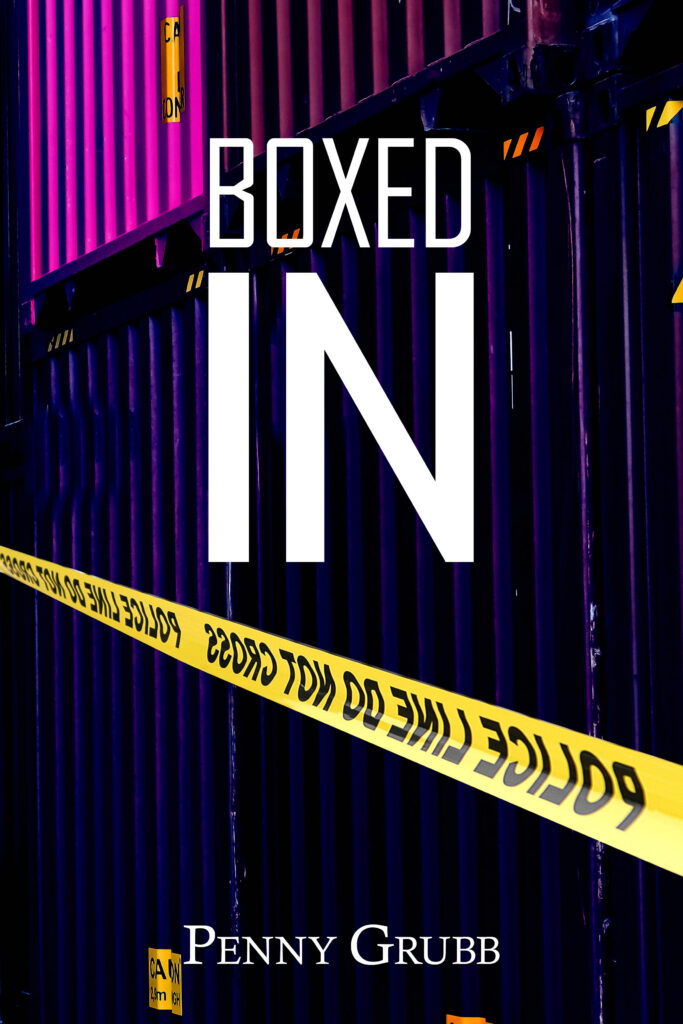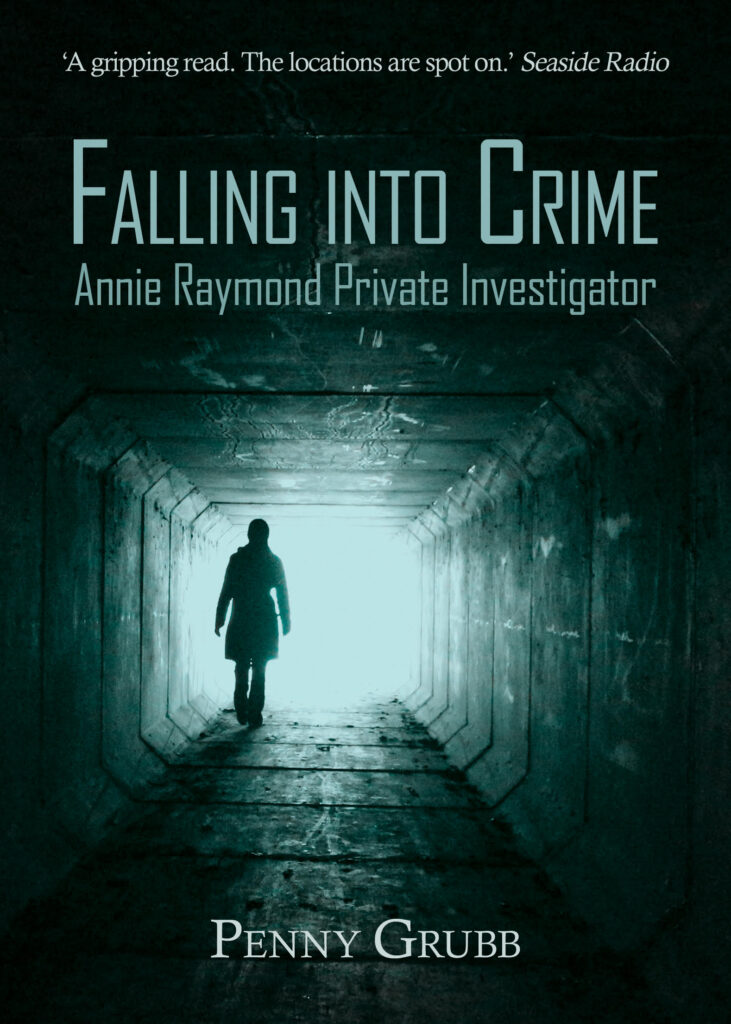

How much research did you need to do for your book?
More than I’d bargained on. I wanted the opening scene of Boxed In to play out in a container yard. I knew nothing about the world of shipping containers, but wanted what happened to be credible in the real world so I went exploring.
One thing led to another and I read far more words than I ended up writing – that’s not unusual.
As with almost any area when you start to dig, there is some fascinating detail out there. Shipping containers – as big and cumbersome as they are – get lost, get stolen, fall from ships, go missing on road journeys. They rarely do the return journey from their original home. They’re repurposed. They become anything from houses to art installations.
I discovered that the sea floor is littered with containers, but bizarrely not always with a negative effect on the ecosystem. Not all containers that fall from ships sink to the bottom. Some of them float just below the surface, often invisible until too late, and become serious hazards especially to yachts.
Less than 1% of what I learnt made it into the book, but that hidden 99% gives me confidence that the story is set against a real world.
Have you ever traveled as research for your book?
I have done short journeys to check out the geography of a route or the lie of the land when the book has been set in my local area as most of them are.
I have also squirrelled away detailed notes from work trips over the years. The one that sticks in my mind was a trip to Davos in Switzerland for a conference in the late 1990s. The railway snaking up the mountain caught my imagination as the perfect setting for a chase. I researched mountain railways, avalanche control strategies and air traffic control. I even wrote the first draft of the book. But it involved the sabotage of a passenger plane and then 9-11 happened, and I didn’t want to write it anymore. It’s probably at the back of a cupboard somewhere, but unlikely to see the light of day.
As a child, what did you want to do when you grew up?
I announced my intention to be a novelist when I was 4. I’d just written my first book. It took me all day! It was 2 sentences long, featuring a cat and a dog, and I had to ask for help to spell its only 2-syllable word.
Stories were part of our childhood. We (my three siblings and I) created innumerable fictional worlds, some with complex histories and cultures. We wrote it all up in small notebooks and argued fiercely over obtuse areas of law in our complex worlds. We are all now published writers.
My “I’m a novelist” announcement was premature as it took half a century before a publisher took a novel from me, but I was always a writer.
Do you participate in writing challenges on social media? Do you recommend any?
Writing challenges are something I’ve only taken part in very recently. When the covid pandemic put us all into lockdown, I started online blogging on Medium where writing challenges abound, and lately I’ve tripped over some that have taken my fancy. For example, I recently wrote “Be Honest!” in a challenge to delve into blogging life: https://tinyurl.com/3vhday6p
Continuing the honesty theme, I admit I’ve not done many of these challenges. Would I recommend them? I don’t know. I’ve enjoyed doing the ones I’ve done. If I didn’t enjoy them, I wouldn’t do them. So I guess my advice is, if a challenge inspires you, have a go.
Have you ever considered writing under a pseudonym, and why or why not?
It wasn’t something I’d ever thought of until a publisher told me that if I wanted to make the jump from adult crime to pre-teen fantasy, I should write under a pseudonym. After due consideration, I did.
For crime, I’m me. For my Horse of a Different Colour books, I’m Melodie Trudeaux. I wrote about the pseudonym in an article called My Alter Ego Is A Children’s Writer: https://tinyurl.com/4awuehkz
Are there therapeutic benefits to modeling a character after someone you know?
I’m sure there are therapeutic benefits for some authors, but the one time I did it, it didn’t work out.
It was one of the baddies in my pre-teen fantasy books. I won’t name names, but looking back I feel I was being lazy. I modelled them on someone who had behaved vindictively towards a friend of mine. I found it restrictive. Other than a vindictive streak, the real person had nothing in common with the fictional character. It was really difficult to get my head around writing the book character doing things that I knew were alien to the real person’s life experience.
However, I have used specific traits I’ve observed in others to help to keep my characters consistent. An abnormal tenacity in holding a grudge was one example. I wrote a character who had this trait, and I used a real person’s grudge-holding abilities as a gauge. I recall reaching a scene where it felt unrealistic to have this character fail to show some empathy. I thought back to my “trait-model”, asking myself what they would do in this situation – would they show some compassion or chuck the victim under the bus?
Once the real person was in my head, the answer was glaringly obvious – under the bus without a second thought. And bam … the character was back on track, and the story could unfold.
Have you ever killed off a character your readers loved?
Not killed as such, but in The Doll Makers, Annie is in a relationship with Mike. It’s the first proper relationship she’s had. She’s not a trusting sort and her upbringing didn’t leave her with much faith in human nature. By instinct, she feels safer going it alone. But Mike fights through the armour and it seems they might make a go of it. The book ends with things looking promising.
However, by the start of the next one, Where There’s Smoke, they have split up and gone their separate ways. Annie has moved North, Mike has gone abroad. And that – I thought – was the end of Mike. Then something unexpected happened.
Mike fans kept popping up at book events. Where was Mike? I was bringing him back, wasn’t I? It seemed they loved Mike and felt that he and Annie were just right together. In some ways they were, but I always felt that their goals in life were too far apart for them to stay together. When asked about his return, I always said, Maybe, because… well, never say never…
And four books later, Mike returned. He’d chased his own ambitions. They’d partly worked out and partly not. They were both older and more worldly wise. He and Annie suddenly made a better team, a more equal partnership, still full of friction and sniping but it was working out.
Fortunately, it never occurred to me to kill Mike between books, though I took him to the brink on the page, and I’m glad now that he remained a ghostly presence for those four books, because now he’s back and taking the underlying story in a whole new direction.
If you’re planning a sequel, can you share a tiny bit about your plans for it?
Boxed In is book 8 in the series and for book 9, my current plan is to focus on Tommy Marchant, a Detective Constable who first appeared in Buried Deep, and who has had minor roles since then, including in Boxed In. Tommy’s major aim in life is to coast his way to retirement and have enough time to indulge his passion for sea-fishing.
Lately, I’ve found myself curious about his past. He is definitely someone with a past, and one he doesn’t brag about. I’ve decided it’s time to shine a light into some murky corners and find out just what he’s been up to. So far, I’ve written two chapters and will probably throw them both out and start again.
That will be the sequel, but that won’t be my next book. For my next book, I’m going right out of this series for a completely different type of crime novel – quite possibly under another pseudonym.
It’s a book called Death By Column Inches and I wrote the first draft in the 1990s. It had a publisher interested and I was rewriting the parts that didn’t work. Believe me, it needed the revision. It took a long time to get right. And before that happened, it got side-lined when one of the crime series won a CWA Dagger. It then got stuck in a gap of being neither a contemporary novel nor set far enough into the past. It is inextricably attached to a particular few years in the 1990s.
It’s taken me until now to get it out of the cupboard, dust it off, give it a good polish and finally get it right. It’s a Marmite book and I suspect the crime series fans will hate it, so a pseudonym might be called for.
What advice would you give to a writer working on their first book?
Here’s something I wish I’d got to grips with sooner. I knew that a concise pitch for a book could be invaluable e.g. for selling it to a publisher or agent, or for constructing a compelling blurb, but I just assumed a pitch was something to worry about after the book was finished.
However, it can be massively useful to the writing process. It can help to keep a book on track, to give you a firm grasp on where it needs to go. Or even to get you started if the book is still an amorphous idea that refuses to turn into actual words on a page.
Creating a pitch really makes you focus. It forces you to see the essence of your story because you can’t write a pitch without teasing that out. If you can’t define the essence of it, you won’t write a focused story.
Oh, and don’t believe anyone who tells you that a pitch is hard to write. I used to think that, but it’s not. I found a really useful technique, and being a writer, I wrote about it in an article called Making Light Of The Dreaded Elevator Pitch https://tinyurl.com/2p8yebuc
How many books have you written? Which is your favorite?
I’ve had 8 crime novels published with a 9th due out soon, also 2 pre-teen fantasies, 2 textbooks, and a non-fiction guide to writing genre fiction. In terms of books written, the number is much higher, as I’m sure is the case for many writers. I spent a long apprenticeship writing an average of two novels a year prior to getting the hang of the whole thing and writing books that were good enough to be let out into the world.
I’m fond of them all and my favourite is a movable feast. I have a soft spot for the textbooks: the first edition of Software Maintenance: concepts and practice is the only book I’m aware of that’s illustrated with Danuta Kot’s cartoons. She’s known for being a best-selling novelist, but should also be known as a talented cartoonist.
From the crime series, I often pick Buried Deep as a favourite. It was the book that turned the series in a different direction. But my current favourite, because it has been neglected for so long, is Death by Column Inches, the book that’s been languishing unloved since the 1990s.
Social media links
Medium articles: https://tinyurl.com/373pax7s
Facebook author page: https://www.facebook.com/PennyGrubbAuthor
Twitter: @PennyGrubb